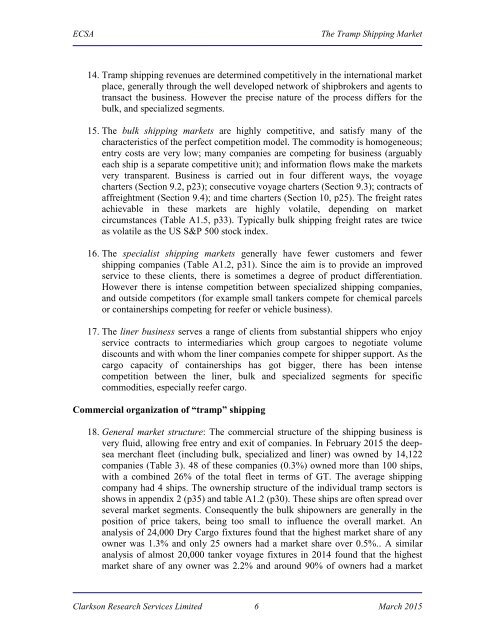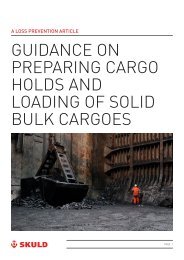You also want an ePaper? Increase the reach of your titles
YUMPU automatically turns print PDFs into web optimized ePapers that Google loves.
<strong>ECSA</strong><br />
<strong>The</strong> <strong>Tramp</strong> <strong>Shipping</strong> <strong><strong>Mar</strong>ket</strong><br />
14. <strong>Tramp</strong> shipping revenues are determined competitively in the international market<br />
place, generally through the well developed network of shipbrokers and agents to<br />
transact the business. However the precise nature of the process differs for the<br />
bulk, and specialized segments.<br />
15. <strong>The</strong> bulk shipping markets are highly competitive, and satisfy many of the<br />
characteristics of the perfect competition model. <strong>The</strong> commodity is homogeneous;<br />
entry costs are very low; many companies are competing for business (arguably<br />
each ship is a separate competitive unit); and information flows make the markets<br />
very transparent. Business is carried out in four different ways, the voyage<br />
charters (Section 9.2, p23); consecutive voyage charters (Section 9.3); contracts of<br />
affreightment (Section 9.4); and time charters (Section 10, p25). <strong>The</strong> freight rates<br />
achievable in these markets are highly volatile, depending on market<br />
circumstances (Table A1.5, p33). Typically bulk shipping freight rates are twice<br />
as volatile as the US S&P 500 stock index.<br />
16. <strong>The</strong> specialist shipping markets generally have fewer customers and fewer<br />
shipping companies (Table A1.2, p31). Since the aim is to provide an improved<br />
service to these clients, there is sometimes a degree of product differentiation.<br />
However there is intense competition between specialized shipping companies,<br />
and outside competitors (for example small tankers compete for chemical parcels<br />
or containerships competing for reefer or vehicle business).<br />
17. <strong>The</strong> liner business serves a range of clients from substantial shippers who enjoy<br />
service contracts to intermediaries which group cargoes to negotiate volume<br />
discounts and with whom the liner companies compete for shipper support. As the<br />
cargo capacity of containerships has got bigger, there has been intense<br />
competition between the liner, bulk and specialized segments for specific<br />
commodities, especially reefer cargo.<br />
Commercial organization of “tramp” shipping<br />
18. General market structure: <strong>The</strong> commercial structure of the shipping business is<br />
very fluid, allowing free entry and exit of companies. In February <strong>2015</strong> the deepsea<br />
merchant fleet (including bulk, specialized and liner) was owned by 14,122<br />
companies (Table 3). 48 of these companies (0.3%) owned more than 100 ships,<br />
with a combined 26% of the total fleet in terms of GT. <strong>The</strong> average shipping<br />
company had 4 ships. <strong>The</strong> ownership structure of the individual tramp sectors is<br />
shows in appendix 2 (p35) and table A1.2 (p30). <strong>The</strong>se ships are often spread over<br />
several market segments. Consequently the bulk shipowners are generally in the<br />
position of price takers, being too small to influence the overall market. An<br />
analysis of 24,000 Dry Cargo fixtures found that the highest market share of any<br />
owner was 1.3% and only 25 owners had a market share over 0.5%.. A similar<br />
analysis of almost 20,000 tanker voyage fixtures in 2014 found that the highest<br />
market share of any owner was 2.2% and around 90% of owners had a market<br />
Clarkson Research Services Limited 6 <strong>Mar</strong>ch <strong>2015</strong>




